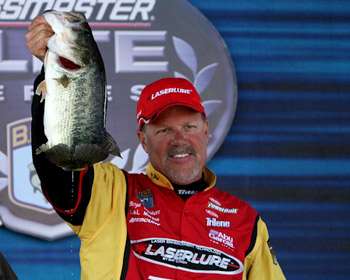
Boyd Duckett's name is more associated with old school baits like deep diving crankbaits, Texas rigged plastics and jigs, but he's not ashamed to admit that a spinning rod is never far from his grip. And more often than not there's a drop shot rig tied to the end of it.
"In at least half of my tournaments, I weigh some fish I've caught on a drop shot," he says.
The drop shot is fairly easy to rig. Simply tie a small hook (one that matches the finesse worm, grub or other small soft plastic bait you're using) onto the line with a Palomar knot, leaving a foot or more of excess line beneath the hook. Add a drop shot weight to the end of the line, spacing it from 6 to 12 inches below the bait. To fish it, let the weight touch bottom, and then gently shake the line, causing the lure to quiver above the bottom.
While using the drop shot is an easy way to supplement your catches, it's not necessarily an easy rig for the average bank-beater to learn. "The drop shot is misunderstood by a lot of anglers," Duckett explains. "They might get out on a point and fish it, but they'll throw it and they'll drag it back like a Carolina rig. You can catch fish doing that, but it's not really capitalizing on the advantage of the drop shot."
He says that the drop shot particularly shines in deep water, or when fish are suspended, but it's not a search bait. Typically, Duckett employs it after he has spotted fish on his depthfinder screen. If he sees scattered arches but can't get the fish to strike a moving bait, he'll try to guess where the fish are and drop the rig down to them.
Ideally, that entails just opening the bail and feeding the line straight down in a vertical presentation, but that's not always possible. If the arches are directly under the boat and the fish bite readily, you can drop it straight down. That's typically the way he catches them at Lake Erie, where aggressive smallmouth don't seem to mind the boat above them.
"But if they're real spooky, you can't drop it straight under the boat," Duckett explains. "A lot of times it helps to get the boat positioned with the trolling motor so that you'll drift and then throw it away from the boat and drag it behind the boat. You're in 'fresh' water the entire time."
The rig's advantage is that it takes absolutely zero horizontal movement to trigger strikes. In fact, the longer you can stand to keep it in one spot the better.
"I don't move it much at all," Duckett says. "I try to keep it in one place and shake it and stimulate a bite from the fish that I can see on the graph. I shake the worm a lot because I'm trying to make a fish bite that wouldn't bite otherwise. Boat dock fishing is a great opportunity for drop shotting. When the fish are on brushpiles and everybody is dragging a 10-inch worm or a heavy jig through the brush, you can clean up with a drop shot. You have to be careful, though, because you're using a spinning rod with light line. You just let it sit there and shake it. It's a high probability place for a fish to be, even though it might take a minute or so before the bass will bite."
He says it's great for bass that aren't interested in eating and which won't hit big spinnerbaits, crankbaits or worms. "The deep drop shot allows you to target a specific bass. If you know the lake well, it's especially an advantage because you'll know where they concentrate," he adds.
For that reason, it's also deadly on suspended fish, which are typically some of the most finicky. The key to catching them, he says, is to use the lightest weight possible to still get it down into their wheelhouse. "A lot of times they'll hit it while it's dropping. Like on Lake Erie, you might be out in 50 feet of water and the fish are in 30, but if you'll drop it down and shake it and shake it as it falls, at some point your line will just get tight."
Over the past several years, Duckett has employed the drop shot rig in both practice and in tournaments to better understand the schools of fish that he finds. In four-day Elite Series tournaments, he wants to find the biggest schools possible and then milk them for everything they're worth, so he prefers to fish offshore if possible.
"I usually look offshore first and then move in, whereas some of the guys probably start in and then move out," he says. "I'd prefer to find deep water fish virtually every place we go."
Even when he's casting to the bank, Duckett keeps the finesse rig handy in case he spots some fish arches on his graph. That's what happened at the 2009 Battle on the Border at Lake Amistad, where he finished ninth and had over 20 pounds each of the first two days. He was casting a swimbait for bigger bass but kept the drop shot close at hand. Later, he threw a jig on a deep water bluff but when he saw some promising arches he employed the drop shot. It produced a 6-pounder one day and a 7 the next, propelling him into the final cut.





